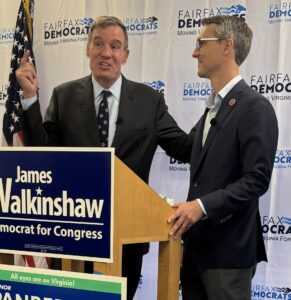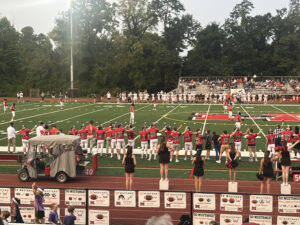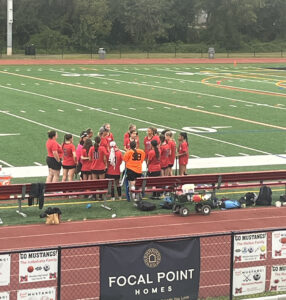In one of the largest turnouts in recent years, the annual march in downtown Falls Church honoring the nation’s greatest civil rights and moral justice champion, Dr. Martin Luther King Jr., drew hundreds on an uncommonly warm and clear day this past Monday. The youth-heavy short walk from the civil rights arch, commemorating the first ever rural chapter of the NAACP founded nearby, on S. Washington St. to the nearby Falls Church Episcopal Church was bedecked with home made banners and signs calling for further progress on racial justice, many made on the spot at tables with magic markers and wooden poles to carry the signage masterpieces.
Edwin B. Henderson III, grandson of that rural chapter’s founder, Edwin Henderson and founder of the current Tinner Hill Foundation, told the News-Press he was thrilled with the large turnout. Heading the march, he also took part in the forum on restorative justice held in the sanctuary of the church that was keynoted by the Virginia Commonwealth Attorney for this area, the innovative and forward-thinking Parisa Dehghani-Testa.
She spoke on the issues surrounding the new law enforcement priorities under the popular rubric of “restorative justice” that seeks to find ways toward reconciliation involving persons charged with victimless and non-violent crimes, which would have a very powerful impact on minorities, in particular.
The plight of blacks since the Civil War was first applied through a wide range of highly prejudicial so-called “Jim Crow” laws, she noted, including widespread illegal lynchings, and in more modern times by the startlingly-high incarceration rates of blacks in prisons as well as practices like real estate redlining and residential zoning implemented to keep blacks out of certain neighborhoods that exist to this day.
Dehghani-Testa was joined on the dais of the church’s modern sanctuary by the Episcopal Church’s Virginia Diocese canon for racial justice, J. Lee Hill. The two constituted a panel moderated by the local church’s Amy Marshak, formerly a clerk for the late U.S. Supreme Court justice Ruth Bader Ginsburg. The panel was introduced by the historic Episcopal Church’s Senior Rector Burl Salmon, an openly gay religious leader in downtown Falls Church on whose property the Civil War against slavery was fought.
Dr. King “invited us to a moral code, a new world,” the Rev. Hill stated. “He called us to a ‘beloved community’ of the Kingdom of God, that is, the ‘kin-dom’ of God. and he calls us to moral courage.”
On the importance of “restorative justice” and other progressive initiatives, Dehghani-Tasta said that despite imperfections in the system, “We have to start somewhere.”
In his MLK Jr. Day message, Jeffrey McKay, chair of the Fairfax County Board of Supervisors, wrote online that, “In January, we recognize and celebrate the life of Martin Luther King Jr. Dr. King’s leadership, in written and spoken word and in leading a series of nonviolent protests, helped bring about Civil Rights for Black Americans. Thanks to his efforts and those of other civil rights groups, discrimination based on race, color, religion, sex, and national origin became unlawful with the passage of the Civil Rights Act of 1964.
“Here in Fairfax County we have our own way of celebrating alongside the nation for Dr. King’s birthday. Volunteer Fairfax joined many other County organizations on Monday for a series of events to honor his inclusivity and his service to others. This important work empowers and strengthens our community, helps to address social problems, eliminates barriers, and moves us closer to the vision Dr. King shared of a ‘Beloved Community.’ In fact, communities of color are driving Fairfax County’s population increase, and their ability to thrive and participate is critical to the County’s success.
“We continue his vision by promoting equity within Fairfax County with our One Fairfax policy and by creating pathways to good jobs, connecting younger generations with older ones, integrating immigrants into the economy, building communities of opportunity throughout the County, and ensuring educational and career pathways for all youth. Our County can place all residents on the path toward reaching their full potential and secure a bright future for the whole community.”













